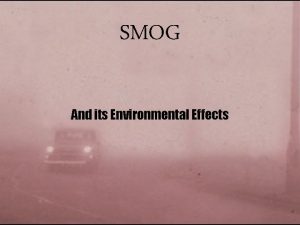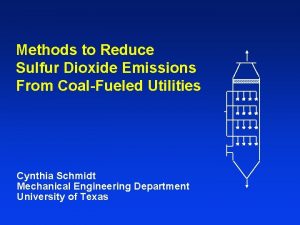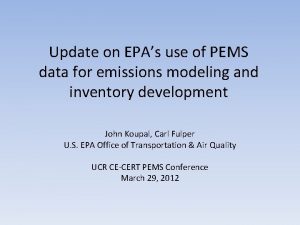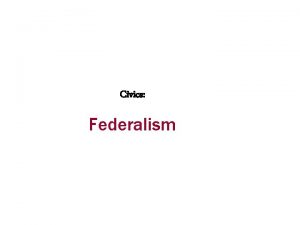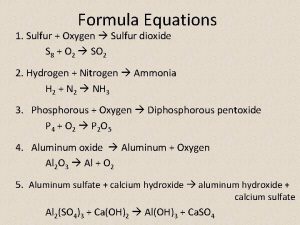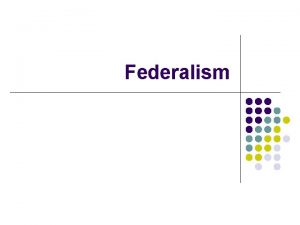Environmental Federalism and Sulfur Dioxide Emissions from Electricity











- Slides: 11

Environmental Federalism and Sulfur Dioxide Emissions from Electricity Plants B. Andrew Chupp H. Spencer Banzhaf

Introduction What level of government should regulate environmental problems? The optimal solution: A system where each state is responsible for all of the damages it generates. Current Options: – Make states self-regulatory. – Federal regulation that is constrained to a uniform policy.

Research Questions Are interstate spillovers or heterogeneity in damages the bigger problem? – This research examines the case of sulfur dioxide and nitrogen oxide emissions from the electricity sector to determine which policy is closer to the optimum. Is the optimal state level policy an indicator of how likely that state is to adopt green electricity laws? Does the most beneficial uniform policy of each state influence legislative voting on environmental issues?

Literature Review Oates and Schwab (1988) and others Dinan et al. (1999) List and Gerking (2000), and others Banzhaf et al. (2004)

Data and Methodology Haiku – A detailed simulation model developed by RFF that allows a per-unit tax to be implemented and then forecasts emissions. – A MCA curve can be derived and then smoothed to eliminate inconsistencies. TAF – An integrated assessment model of air pollution. – Includes source-receptor matrices. – Only health effects were included. – Uses constant marginal damage estimates. – I varied one state’s emissions while holding other states at the baseline to see the change in benefits.

Methodology (cont. ) By observing the intersection between the MCA curve and the state’s own benefits of abatement, I obtain the state-level optimal abatement. By repeating this process for the nationally optimal uniform tax and the truly optimal differentiated policy, I obtain all levels of abatement.

Results State MC Optimal MC St Abate Op Abate Un Abate St Pctg Un Pctg AL $343. 41 $4, 131. 05 8, 334. 8 283, 160 2. 94% 100. 00% AZ $247. 80 $1, 707. 51 1, 087. 7 7, 465. 8 14, 013 14. 57% 187. 70% AR $375. 59 $4, 637. 93 158, 670 334, 470 334, 060 47. 44% 99. 88% CA $4, 975. 46 $6, 199. 27 7, 127. 3 7, 149. 8 7, 143. 6 99. 69% 99. 91% CO $291. 53 $1, 632. 33 6, 061. 4 44, 902 69, 091 13. 50% 153. 87% CT $1, 060. 46 $3, 739. 77 7, 224. 8 11, 353 11, 418 63. 64% 100. 57% DE $81. 56 $2, 526. 79 19, 444 146, 720 148, 490 13. 25% 101. 21% FL $1, 240. 30 $3, 528. 00 257, 900 389, 960 390, 020 66. 13% 100. 02% GA $482. 79 $3, 825. 17 445, 870 902, 190 902, 220 49. 42% 100. 00% IL $795. 19 $4, 207. 50 1, 664, 600 2, 107, 100 79. 00% 100. 00% IN $435. 29 $4, 271. 14 978, 530 1, 478, 700 1, 478, 600 66. 18% 99. 99% IA $139. 51 $3, 184. 11 1, 799. 5 34, 705 41, 562 5. 19% 119. 76% KS $113. 87 $2, 943. 90 616. 25 54, 528 56, 236 1. 13% 103. 13%

Results The state level policies result in a loss of $18, 823, 285, 459 from the nationally optimal fully differentiated policy. This reflects roughly 31. 6% of the total benefits. The nationally optimal uniform policy results in a loss of $119, 596, 886 from the optimal policy (0. 20% of the total benefits). The uniform policy is closer to the nationally optimal policy.

Adoption of Green Electricity Policies I use the state level preferred policies as explanatory variables to determine which states are more likely to adopt green electricity policies. – Renewable portfolio standards – Generation disclosure rules – Net metering rules – Public benefit funds Vachon and Menz (2006)

Congressional Voting Using the Haiku and TAF models, I am able to derive the uniform tax levels preferred by each state. Each state’s preferred uniform tax can help explain how its Senators and Representatives vote on national environmental and energyrelated bills. Prior work on Congressional roll call voting attempts to disentangle the effects of the legislator’s ideology and the actual interest of his or her constituency. My measure is the ideal measure of the interest of the population since it truly reflects the costs and benefits of environmental legislation.

Questions
 Sulfur dioxide and limestone
Sulfur dioxide and limestone Sulfur dioxide smog
Sulfur dioxide smog How to reduce sulfur dioxide
How to reduce sulfur dioxide Static electricity and current electricity
Static electricity and current electricity Current electricity
Current electricity Electricity and magnetism vocabulary
Electricity and magnetism vocabulary Volkswagen quiz
Volkswagen quiz Sparse matrix operator kernel emissions
Sparse matrix operator kernel emissions Diesel emissions denver
Diesel emissions denver Sources of nox emissions
Sources of nox emissions Parts of a sperm cell
Parts of a sperm cell Pems emissions modeling
Pems emissions modeling

